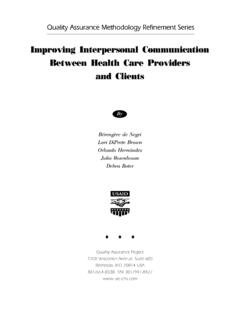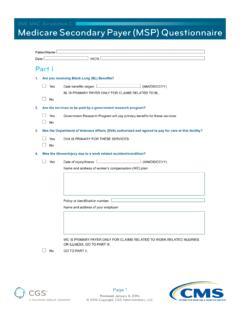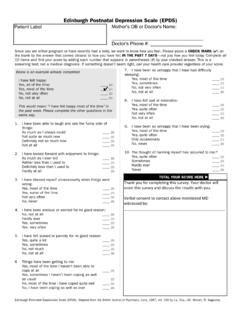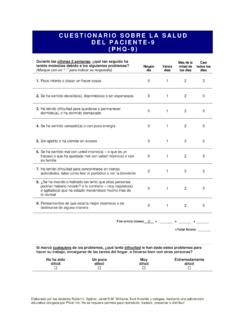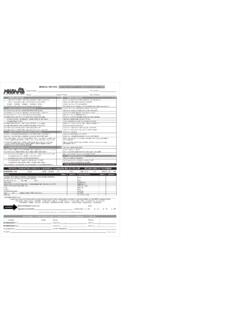Transcription of Evaluation Toolkit - Centers for Disease Control and ...
1 National Center for HIV/AIDS, Viral Hepatitis, STD, and TB Prevention Division of HIV/AIDS Prevention Evaluation Toolkit : Patient and Provider Perspectives about Routine HIV Screening in health Care SettingsThis guide was developed through a cooperative agreement between the Centers for Disease Control and Prevention, the Center for AIDS Prevention Studies at the University of California, San Francisco and the Fran ois-Xavier Bagnoud Center in the School of Nursing, University of Medicine and Dentistry of New Jersey. All material in this guide is in the public domain and may be used and reproduced without permission. Citation of the source is, however, citationOn the Web: guide was prepared by:Kristina E.
2 Bowles, Division of HIV/AIDS Prevention, CDCJ anet Myers, University of California, San FranciscoDeborah S. Storm, University of Medicine and Dentistry of New JerseyCarolyn K. Burr, University of Medicine and Dentistry of New JerseyAndre Maiorana, University of California, San FranciscoMi-Suk Kang Dufour, University of California, San FranciscoAcknowledgmentsBernard M. Branson, MD, Division of HIV/AIDS Prevention, CDCJohn J. Cienki, MD, FACEP, Jackson health SystemDeborah Cohan, MD, MPH, University of California, San FranciscoCraig Dietz, DO, MPH, Kansas City Free health Clinic Krisztina Emodi, RN, MSN, MPH, San Francisco General Hospital and the University of California, San Georgetti, MSPHJ ason Haukoos, MD, MSc.
3 Denver health Medical Center Lori Lee, BAKathy McNamara, RN, National Association of Community health Centers Steve O Brien, MD, Alta Bates Summit Medical CenterPhyllis Schoenwald, PA, Planned Parenthood Shasta-DiabloRenee Stein, PhD, Division of HIV/AIDS Prevention, CDC Lynn Sullivan, MD, Yale University School of Medicine Douglas White, MD, Alameda County Medical CenterCenters for Disease Control and Prevention. Evaluation Toolkit : Patient and Provider Perspectives about Routine HIV Screening in health Care Settings. Published March 2012. Accessed [date].iii Table of ContentsIntroduction ..1 Background ..1 Purpose ..1 Overview of the Questionnaires ..2 patient questionnaire .
4 2 questionnaire for health care Providers and Staff (Provider questionnaire ) ..3 Getting Started ..3 Identifying Staff and Fiscal Resources ..4 Timeline for Evaluation Activities ..4 Obtaining Required Approvals from Administrators and Institutional Review Boards (IRBs) ..4 Garnering Staff Support ..5 Adapting the Questionnaires ..5 Determining Sampling Method and Sample Size ..6 Recruitment Scripts ..8 Consent and Confidentiality ..8 Administering the questionnaire ..8 Data Analysis and Developing Reports ..9 Report Templates ..10 Disseminating questionnaire Results ..12iv Using questionnaire Results for Quality Assurance and Continuous Quality Improvement (CQI).
5 13 Summary ..15 References ..16 Appendix A Evaluation Plan Template ..17 Appendix B1 patient questionnaire (English) ..21 Appendix B2 patient questionnaire (Spanish) ..28 Appendix C Provider questionnaire ..35 Appendix D Summary of Topics and Items for Patient & Provider Questionnaires ..391 IntroductionIntroductionBackgroundIn 2006, the Centers for Disease Control and Prevention (CDC) published the Revised Recommendations for HIV Testing of Adults, Adolescents and Pregnant Women in health Care Settings (Branson, Handsfield, et al. 2006). CDC recommends routine HIV screening in health care settings using an opt-out approach in order to increase the number of patients being screened for HIV infection, detect HIV infection earlier and link patients with unrecognized HIV infection to clinical and prevention reduce barriers to HIV screening and make HIV tests similar to other types of health screenings, CDC recommends that separate written consent and prevention counseling should not be required with diagnostic testing or screening implementation of routine HIV screening requires a change in practice for most health care settings and may involve new types of testing procedures.
6 Such as point-of-care rapid HIV tests as opposed to laboratory-based HIV testing procedures. As part of implementation, health care settings may collect a range of statistics about their testing program, such as the number of patients screened, percentage of preliminary positive tests, proportion of those with preliminary positive results undergoing confirmatory testing, and percent of confirmed positives linked successfully to care. These statistics, while important, do not provide information on patient or provider perspectives about routine HIV screening in health care settings, including patient satisfaction with and acceptance of HIV patient and provider perspectives is an integral component of evaluating clinical programs to improve clinical services.
7 The purpose of this Evaluation Toolkit is to offer a package of Evaluation materials that can be used to determine the effect that expanded HIV screening activities has on patient attitudes toward and accepting HIV testing. health care organizations and providers can use the results from the Evaluation Toolkit for a number of different purposes: To evaluate patient experiences and satisfaction with routine HIV screening. To inform customer satisfaction and quality assurance initiatives related to the implementation of a new service. To examine progress with the implementation of routine HIV screening and identify areas for quality improvement by conducting periodic evaluations.
8 To identify concerns of patients and providers that may pose barriers to acceptance of HIV screening or may hinder effective defines opt-out screening as: Performing HIV screening after notifying the patient that 1) the test will be performed and 2) the patient may elect to decline or defer testing. Assent is inferred unless the patient declines testing [Branson, Handsfield, et al. 20062 Overview of the QuestionnairesOverview of the QuestionnairesThe Evaluation Toolkit includes a patient questionnaire and a health care provider and staff questionnaire . This section provides information on each of the questionnaires and how and when to administer them to both patients and QuestionnaireThe patient questionnaire provides a mechanism to obtain patients perspectives about routine HIV testing in various health care settings including, but not limited to, emergency departments and public or private clinics.]
9 This tool will help assess patient preferences and satisfaction with and attitudes towards CDC-recommended practice, including opt-out screening, pre-test information and different methods of receiving test patient questionnaire was developed through a review of the literature on patient acceptability of routine HIV testing, including Evaluation of previously published patient satisfaction tools (Dietz, Ablah, et al. 2008; Steward, Herek, et al. 2008) and consultation with health care providers implementing routine HIV testing. The questionnaire underwent cognitive testing with 4 patients visiting a public clinic to assess clarity and comprehension of the questionnaire items.
10 The questionnaire was then revised and pilot tested among 272 patients in three types of health care settings: a publicly funded health clinic, a private clinic providing reproductive health services and an emergency department. Data from the pilot testing were used to assess the instrument s validity, identify additional question revisions, and inform the content of the patient questionnaire is designed to be offered to adolescent and adult patients receiving health care services at a time when routine HIV screening is available at the facility, irrespective of whether they received an HIV test. The questionnaire is available in English (Appendix B1) and Spanish (Appendix B2).










